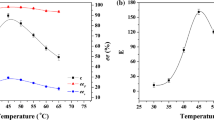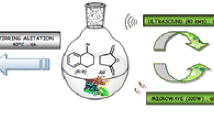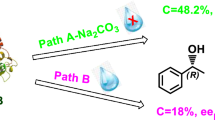Abstract
The enantioselectivity of the transesterification of the 2,2,2-trifluoroethyl esters of 2-(substituted phenoxy)propanoic acids, as catalyzed by the lipase from Carica papaya, was greatly improved by using long-chain ethers, such as di-n-hexyl ether, as solvents instead of the conventional diisopropyl ether. Thus, for example, the E value was enhanced from 21 [in diisopropyl ether (0.8 ml)] to 57 [in di-n-hexyl ether (0.8 ml)] in the reaction of 2,2,2-trifluoroethyl(RS)-2-phenoxypropanoate (0.1 mmol) with methanol (0.4 mmol) in the presence of the plant lipase preparation (10 mg); it was also improved from 13 (in diisopropyl ether) to 44 (in di-n-hexyl ether) in the reaction of 2,2,2-trifluoroethyl(RS)-2-(2-chlorophenoxy)propanoate with methanol under the same reaction conditions.
Similar content being viewed by others
Explore related subjects
Discover the latest articles, news and stories from top researchers in related subjects.Avoid common mistakes on your manuscript.
Introduction
Lipases are a very attractive group of enzymes for synthetic purposes (Faber 2011; Paravidino et al. 2012). They have successfully been employed for the preparation of optically active forms of a wide range of alcohols and carboxylic acids via hydrolysis, esterification, or transesterification. Organic media are ordinarily employed for such transformations and they can affect not only the activity but also the selectivity of enzymes (Koskinen and Klibanov 1996). The most reliable measure for the compatibility of an organic solvent with high enzyme activity has been obtained by using log P describing the hydrophobicity of the solvent (Laane et al. 1987). In general, solvents with log P values >2 cause negligible enzyme distortion. Those with log P values between 1.5 and 2 cause some distortion, but they can be used with caution. Therefore, such solvents as diisopropyl ether [log P = 1.52 (Sangster 1989)] are often employed.
Lipases for synthetic purposes have been limited to those from mammalian and microbial sources. Carica papaya lipase (CPL), stored in crude papain, was exploited for the kinetic resolutions of chiral acids (Cheng and Tsai 2004; Chen and Tsai 2005; Ng and Tsai 2005). We also reported the kinetic resolution of amino acids (Miyazawa et al. 2005) and, more recently, that of secondary alcohols. Chang and Ho (2011) also reported the enantioselective esterification of 2-methylalkanoic acids.
2-Phenoxypropanoic acids are well-known herbicides but also have other biological activities (Witiak et al. 1968; Kawashima et al. 1984). Their resolution has been tried by employing lipases, α-chymotrypsin and pig liver esterase (Cambou and Klibanov 1984; Dernoncour and Azerad 1987; Chen et al. 1987; Pan et al. 1990; Yasufuku and Ueji 1997). We also reported their resolution using Aspergillus niger lipase (Miyazawa et al. 1999). We have investigated their resolution by employing CPL, and we found a marked improvement of enantioselectivity in transesterification by changing solvents.
Materials and methods
Materials
(RS)-2-(Substituted phenoxy)propanoic acids were converted to the 2,2,2-trifluoroethyl esters by the EDC[1-ethyl-3-(3-dimethylaminopropyl)carbodiimide]-DMAP(4-dimethylaminopyridine) method (Dhaon et al. 1982) using 2,2,2-trifluoroethanol. Methyl esters were prepared by treatment of the corresponding carboxylic acids with an ethereal solution of diazomethane. Lipase: crude papain (5 g) was dissolved in distilled water (25 ml), centrifuged (~10,000×g, 12 min) at 4 °C to collect the precipitate and lyophilized to afford the crude C. papaya lipase (CPL 0.75 g) (Miyazawa et al. 2005).
General procedure for the CPL-catalyzed transesterification
CPL-catalyzed transesterification with methanol of 2,2,2-trifluoroethyl(RS)-2-phenoxypropanoate (1a) is described as a typical example. A solution of 1a (0.1 mmol) and methanol (0.4 mmol) in an organic solvent (0.8 ml) was stirred with the lipase preparation (10 mg) in a thermostated bath. The progress of the reaction and the enantiomeric excess (e.e.) value of the newly formed methyl ester were determined directly by chiral HPLC analysis on a Chiralpak AS column (4.6 mm id × 250 mm) or a Chiralcel OD column (4.6 mm id × 250 mm) (Daicel Chemical Industries) using hexane/2-propanol as an eluent. The enantiomers of the methyl esters were separated sufficiently for the accurate determination of the e.e. values on either of the columns by choosing an appropriate proportion of hexane/2-propanol for each compound. In general, the enantiomeric separations of the corresponding 2,2,2-trifluoroethyl esters were inferior to those of the methyl esters.
Results and discussion
In a general experimental procedure, the 2,2,2-trifluoroethyl ester of an 2-(substituted phenoxy)propanoic acid (1) was reacted with an alcohol (4 molar equiv.) in an organic solvent in the presence of CPL at a constant temperature (Scheme 1). The reaction was monitored (conversion and e.e. values) by HPLC on a chiral column. Initially, the parent 2-phenoxypropanoic acid 2,2,2-trifluoroethyl ester (1a) was chosen as a model compound and the effects of reaction parameters were investigated (Table 1).
CPL-catalyzed enantioselective transesterification of a 2-(substituted phenoxy)propanoic acid 2,2,2-trifluoroethyl ester (1) with an alcohol. See Table 2 for the substituent X
According to Faber (2011), the values of enantiomeric ratios, E’s (Chen et al. 1982), below 15 are unacceptable, those in the range of 15–30 are regarded as moderate to good and above this value they are excellent. The reaction of 1a with methanol was very slow in cyclohexane at 25 °C and even at 45 °C. In diisopropyl ether, the reaction was fast enough and afforded a ‘moderate’ enantioselectivity (E = 21) at 25 °C. At 45 °C the reaction became faster at the expense of enantioselectivity. The reactions were retarded in such polar solvents as acetonitrile and acetone, moreover giving poor enantioselectivity. Concerning the effect of alcohol nucleophiles, there was almost no difference between methanol and propanol with regard to the reaction rate but the enantioselectivity was appreciably decreased with the latter alcohol. With hexanol both the conversion rate and enantioselectivity were slightly worse when compared with those with methanol.
Based on the above results, the transesterification with methanol of the 2,2,2-trifluoroethyl esters of 2-(substituted phenoxy)propanoic acid (1) carrying a number of substituents on the benzene ring was examined in diisopropyl ether at 25 °C. The results are compiled in Table 2. The CPL-catalyzed transesterifications proceeded smoothly except the compounds bearing an ortho-chloro substituent (1c and 1f). Among the compounds examined the 2,2,2-trifluoroethyl esters of the parent 2-phenoxypropanoic acid (1a) and its alkyl-substituted compounds (1h and 1i) gave ‘tolerable’ degree of enantioselectivities as judged from the E values (20–22). With the halogen-substituted compounds enantioselectivities were generally low and they were negligible with the compounds 1d and 1f. In the middle column of Table 2 are also included the E values observed in the A. niger lipase-catalyzed irreversible transesterification of 2-phenoxypropanoic acid vinyl esters with methanol in diisopropyl ether (Miyazawa et al. 1999). The enantioselectivities observed in the CPL-catalyzed transesterification were almost of the same magnitude as those observed in the A. niger lipase-catalyzed transesterification. The substituent effect on the enantioselectivity was similar in the two kinds of transesterifications mediated by these different lipases. In all the CPL-catalyzed transesterifications mentioned above, the preferential reaction of the (R)-enantiomers was confirmed by comparison on HPLC with authentic samples prepared form the A. niger lipase-catalyzed transesterification of 2-phenoxypropanoic acid vinyl esters or suggested from the regularity of elution order of the enantiomers on HPLC. This stereochemical preference is the reverse as that observed in the A. niger lipase-catalyzed transesterification of the vinyl esters.
As ‘poor’ to ‘tolerable’ level of enantioselectivities were observed in diisopropyl ether, we envisaged that the use of an ethereal solvent with hydrophobicity similar to or greater than that of cyclohexane could ameliorate them. Table 3 shows the results obtained in such ethereal solvents. The enantioselectivity was slightly worse in a less hydrophobic ether, t-butyl methyl ether. In contrast, it was gratifying to find that when a more hydrophobic ether, di-n-hexyl ether or di-n-octyl ether, was employed the reaction rate was not retarded in any degree and the enantioselectivity was profoundly improved, reaching the ‘excellent’ level. Accordingly, the CPL-catalyzed transesterification with methanol of 1 was reinvestigated in di-n-hexyl ether as a solvent. The results are summarized also in Table 2. The reaction rate was not very much affected by the change of solvents to the long-chain ether. On the other hand, the enantioselectivity was profoundly improved by this change. The level of enantioselectivity was elevated by at least one rank: ‘low’ to ‘tolerable’ or ‘tolerable’ to ‘good’, except 1d. Even in the latter case, however, the E value became 2.6 times larger. Thus, in all the cases examined, the E values became 1.6–3.4 times larger by the use of di-n-hexyl ether as the solvent.
Conclusion
CPL is a promising enzyme for the resolution of 2-(substituted phenoxy)propanoic acids by changing solvents from diisopropyl ether to long-chain ethers which have larger hydrophobicity. This possibility should be considered when the enantioselectivity is inadequate in diisopropyl ether most frequently employed in lipase-catalyzed transesterifications and esterifications. The general applicability of this approach is now under investigation in our laboratory.
References
Cambou B, Klibanov AM (1984) Comparison of different strategies for the lipase-catalyzed preparative resolution of racemic acids and alcohols: asymmetric hydrolysis, esterification, and transesterification. Biotechnol Bioeng 26:1449–1454
Chang C-S, Ho S-C (2011) Enantioselective esterification of (R,S)2-methylalkanoic acid with Carica papaya lipase in organic solvents. Biotechnol Lett 33:2247–2253
Chen C-C, Tsai S-W (2005) Carica papaya lipase: a novel biocatalyst for the enantioselective hydrolysis of (R,S)-naproxen 2,2,2-trifluoroethyl ester. Enzyme Microb Technol 36:127–132
Chen C-S, Fujimoto Y, Girdukas G, Sih CJ (1982) Quantitative analyses of biochemical kinetic resolutions of enantiomers. J Am Chem Soc 104:7294–7299
Chen C-S, Wu S-H, Girdaukas G, Sih CJ (1987) Quantitative analyses of biochemical kinetic resolution of enantiomers. 2. Enzyme-catalyzed esterifications in water-organic solvent biphasic systems. J Am Chem Soc 109:2812–2817
Cheng Y-C, Tsai S-W (2004) Enantioselective esterification of (RS)-2-(4-chlorophenoxy)propionic acid via Carica papaya lipase in organic solvents. Tetrahedron 15:2917–2920
Dernoncour R, Azerad R (1987) Enantioselective hydrolysis of 2-(chlorophenoxy)propionic esters by esterases. Tetrahedron Lett 28:4661–4664
Dhaon MK, Olsen RK, Ramasamy K (1982) Esterification of N-protected α-amino acids with alcohol/carbodiimide/4-(dimethylamino)pyridine. Racemization of aspartic and glutamic acid derivatives. J Org Chem 47:1962–1965
Faber K (2011) Biotransformations in organic chemistry, 6th edn. Springer, Berlin
Kawashima Y, Hanioka N, Kozuka HJ (1984) Pharmacobio-Dyn 7:286–293
Koskinen AMP, Klibanov AM (eds) (1996) Enzymatic reactions in organic media. Blackie, Glasgow
Laane C, Boeren S, Vos K, Veeger C (1987) Rules for optimization of biocatalysis in organic solvents. Biotechnol Bioeng 30:81–87
Miyazawa T, Kurita S, Shimaoka M, Ueji S, Yamada T (1999) Chirality 11:554–560
Miyazawa T, Onishi K, Murashima T, Yamada T, Tsai S-W (2005) Resolution of non-protein amino acids via Carica papaya lipase-catalyzed enantioselective transesterification. Tetrahedron 16:2569–2573
Miyazawa T, Houhashi M, Inoue Y, Murashima T, Yamada T (2008) Resolution of secondary alcohols via Carica papaya lipase-catalyzed enantioselective acylation. Biotechnol Lett 30:1783–1787
Ng I-S, Tsai S-W (2005) Hydrolytic resolution of (R,S)-naproxen 2,2,2-trifluoroethyl thioester by Carica papaya lipase in water-saturated organic solvents. Biotechnol Bioeng 89:88–95
Pan S-H, Kawamoto T, Fukui T, Sonomoto K, Tanaka A (1990) Stereoselective esterification of halogen-containing carboxylic acids by lipase in organic solvent: effects of alcohol chain length. Appl Microbiol Biotechnol 34:47–51
Paravidino M, Böhm P, Gröger H, Hanefeld U (2012) Hydrolysis and formation of carboxylic acid esters. In: Drauz K, Gröger H, May O (eds) Enzyme catalysis in organic synthesis, 3rd edn. Wiley, Weinheim Chapter 8
Sangster J (1989) J Phys Chem Ref Data 18:1111–1227
Witiak DT, Ho TC-L, Hackney RE, Connor WE (1968) Hypocholesterolemic agents. Compounds related to ethyl α-(4-chlorophenoxy)-α-methylpropionate. J Med Chem 11:1086–1089
Yasufuku Y, Ueji S (1997) High temperature-induced high enantioselectivity of lipase for esterifications of 2-phenoxypropionic acids in organic solvent. Bioorg Chem 25:88–99
Author information
Authors and Affiliations
Corresponding author
Rights and permissions
About this article
Cite this article
Miyazawa, T., Iguchi, W. Long-chain ethers as solvents can amplify the enantioselectivity of the Carica papaya lipase-catalyzed transesterification of 2-(substituted phenoxy)propanoic acid esters. Biotechnol Lett 35, 1639–1643 (2013). https://doi.org/10.1007/s10529-013-1247-x
Received:
Accepted:
Published:
Issue Date:
DOI: https://doi.org/10.1007/s10529-013-1247-x





